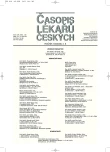Hypertensive crisis – the present view
Authors:
T. Janota
Authors‘ workplace:
Univerzita Karlova v Praze, 1. lékařská fakulta, III. interní klinika VFN
Published in:
Čas. Lék. čes. 2009; 148: 370-373
Category:
Review Article
Overview
Hypertensive crisis is an acute, life-threatening condition associated with a substantial sudden increase in blood pressure. If the increase is accompanied by a damage of brain, cardiovascular system, eye ground or kidneys, it is referred to as an emergent hypertensive situation. In case of complaints comprising chest pain, shortness of breath, headache, epistaxis, weakness, faintness or seizure alone without organ damage, it is referred to as an urgent hypertensive situation. Treatment of emergent situations is parenteral and is conducted under a permanent monitoring in an intensive care unit. Nitrates, urapidil, diuretics, angiotensinconverting enzyme inhibitors, calcium channel blockers, beta blockers and clonidin are used with respect to organ damage and accompanying diseases. Rate of blood pressure reduction and target values depend on a type of organ damages. An escalation of per oral medication is used in the treatment of urgent situations. Parenteral medication is indicated only in case of failure of this approach.
Key words:
hypertensive crisis, emergent hypertensive situation, urgent hypertensive situation, treatment.
Sources
1. Petrášek J, Šimonová J. Kritické stavy ve vnitřním lékařství. Praha: Státní pedagogické nakladatelství 1979.
2. Widimský J jr, Cífková R, Špinar J, Filipovský J, Grundmann M, Horký K, Linhart A, Monhart V, Rosolová H, Souček M, Vítovec J, Widimský J sr. Doporučení diagnostických a léčebných postupů u arteriální hypertenze – verze 2007. Doporučení České společnosti pro hypertenzi. Cor Vasa 2008; 50: K3–K16.
3. The Task Force for the Management of Arterial Hypertension of the European Society of Hypertension and of the European Society of Cardiology. Guidelines Committee 2007. Guidelines for the Management of Arterial Hypertension. J Hypertens 2007; 25 : 1105–1187.
4. Slama M, Modeliar SS. Hypertension in the intensive care unit. Curr Opin Kardiol 2006; 21 : 279–287.
5. Zampaglione B, Pascale C, Marchisio M, Cavallo-Perin P. Hypertensive Urgencies and Emergencies: Prevalence and Clinical Presentation. Hypertension 1996; 27 : 144–147.
6. Cobanian AV, Bakttris BL, Black HR, et al. The Seventh Report of the John National Committee on Prevention, Detection, Evaluation, and Treatment of High Blood Pressure. The JNC 7 Report. JAMA 2003; 289 : 2560–2572.
Labels
Addictology Allergology and clinical immunology Angiology Audiology Clinical biochemistry Dermatology & STDs Paediatric gastroenterology Paediatric surgery Paediatric cardiology Paediatric neurology Paediatric ENT Paediatric psychiatry Paediatric rheumatology Diabetology Pharmacy Vascular surgery Pain management Dental HygienistArticle was published in
Journal of Czech Physicians

- What Effect Can Be Expected from Limosilactobacillus reuteri in Mucositis and Peri-Implantitis?
- Metamizole at a Glance and in Practice – Effective Non-Opioid Analgesic for All Ages
- Spasmolytic Effect of Metamizole
- The Importance of Hydration in Wound Healing
Most read in this issue
- Pheochromocytoma: diagnosis and treatment
- Diagnostics and treatment of organic hyperinsulinism – experience in 105 cases
- Hypertensive crisis – the present view
- Electrocardiography of yesterday and today
